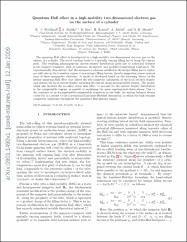| dc.contributor.author | Friedland, K. -J. | |
| dc.contributor.author | Siddiki, Afif | |
| dc.contributor.author | Hey, R. | |
| dc.contributor.author | Kostial, H. | |
| dc.contributor.author | Riedel, A. | |
| dc.contributor.author | Maude, D. K. | |
| dc.date.accessioned | 2020-11-20T16:35:18Z | |
| dc.date.available | 2020-11-20T16:35:18Z | |
| dc.date.issued | 2009 | |
| dc.identifier.issn | 2469-9950 | |
| dc.identifier.issn | 2469-9969 | |
| dc.identifier.uri | https://doi.org/10.1103/PhysRevB.79.125320 | |
| dc.identifier.uri | https://hdl.handle.net/20.500.12809/4800 | |
| dc.description | WOS: 000264769300071 | en_US |
| dc.description.abstract | The quantum Hall effect is investigated in a high-mobility two-dimensional electron gas on the surface of a cylinder. This special topology leads to a spatially varying filling factor along the current path. The resulting inhomogeneous current-density distribution gives rise to additional features in the magnetotransport, such as resistance asymmetry and modified longitudinal resistances. We experimentally demonstrate that the asymmetry relations satisfied in the integer filling factor regime are valid also in the transition regime to noninteger filling factors, thereby suggesting a more general form of these asymmetry relations. A model is developed based on the screening theory of the integer quantum Hall effect that allows the self-consistent calculation of the local electron density and thereby the local current density including the current along incompressible stripes. The model, which also includes the so-called "static skin effect" to account for the current-density distribution in the compressible regions can explain the main experimental observations. Due to the existence of an incompressible-compressible transition in the bulk, the system behaves always metal-like in contrast to the conventional Landauer-Buttiker description, in which the bulk remains completely insulating throughout the quantized Hall plateau regime. | en_US |
| dc.description.sponsorship | NIM Area A; European 6th Framework ProgramEuropean Union (EU) [RITA-CT-3003-505474]; Strategic Japanese-German Cooperative Program [FR 930/16-1, AOBJ 548229] | en_US |
| dc.description.sponsorship | The authors gratefully acknowledge stimulating discussions with R. R. Gerhardts, P. Kleinert, and H. T. Grahn. We thank E. Wiebicke and M. Horicke for technical assistance. One of us, A. S., was financially supported by NIM Area A. The work at GHMFL was partially supported by the European 6th Framework Program under Contract No. RITA-CT-3003-505474, and part of the work was supported by the Strategic Japanese-German Cooperative Program on "Nanoelectronics" under Grants No. FR 930/16-1 and No. AOBJ 548229. | en_US |
| dc.item-language.iso | eng | en_US |
| dc.publisher | Amer Physical Soc | en_US |
| dc.item-rights | info:eu-repo/semantics/openAccess | en_US |
| dc.subject | Carrier Mobility | en_US |
| dc.subject | Current Density | en_US |
| dc.subject | Electron Density | en_US |
| dc.subject | Quantum Hall Effect | en_US |
| dc.subject | Two-Dimensional Electron Gas | en_US |
| dc.title | Quantum Hall effect in a high-mobility two-dimensional electron gas on the surface of a cylinder | en_US |
| dc.item-type | article | en_US |
| dc.contributor.department | MÜ, Fen Fakültesi, Fizik Bölümü | en_US |
| dc.contributor.institutionauthor | Siddiki, Afif | |
| dc.identifier.doi | 10.1103/PhysRevB.79.125320 | |
| dc.identifier.volume | 79 | en_US |
| dc.identifier.issue | 12 | en_US |
| dc.relation.journal | Physical Review B | en_US |
| dc.relation.publicationcategory | Makale - Uluslararası Hakemli Dergi - Kurum Öğretim Elemanı | en_US |


















